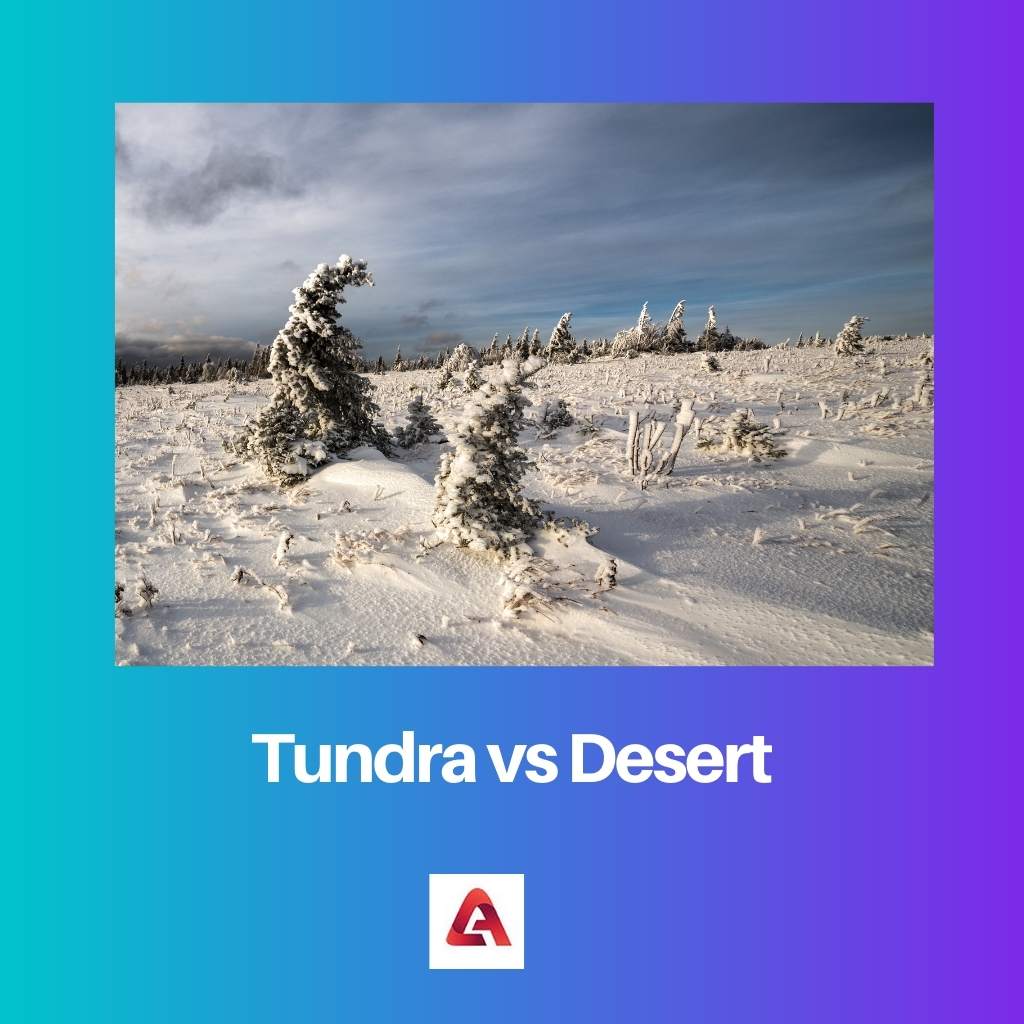Earth has many types of biomes. Tundra and desert are two of them. Both of these biomes are dry and do not procure much rainfall. They do not possess a diversity of flora and fauna, but despite these similarities, they have many differences.
Key Takeaways
- Tundra is a cold, treeless biome with permafrost covering vast Arctic and Antarctic regions, while deserts are arid regions with little rainfall and sparse vegetation.
- Tundra is characterized by low temperatures and a short growing season, while deserts have high temperatures and are subjected to extreme weather conditions.
- Tundra is home to various wildlife adapted to its harsh environment, while deserts are home to animals and plants that have adapted to survive with limited water resources.
Tundra vs Desert
Tundra has a cold climate for most of the year and a very short summer season. There is no vegetation on the tundra due to its low temperature except a few shrubs. Deserts have hot climates having plants and animals that can survive with limited water resources. They lie on the equator of the earth.

Tundra is a cold and dry biome. Only two seasons are available here, winter and summer. However, summer here is very short. Not much vegetation can be seen here, for its low temperature. Mostly dwarf-like shrubs, such as mosses and lichens, grow here.
The desert is a very dry place. Rainfall does not occur. Deserts can have various types. Hot deserts and cold deserts are known. For the scarcity of rain, not much vegetation is available here. Generally, cactus-like trees grow here.
Comparison Table
| Parameters of Comparison | Tundra | Desert |
|---|---|---|
| Definition | Tundra is a very cold and dry biome that has snow-covered lands. | Desert is a dry biome that can be dry or cold, with sand or ice-covered lands, respectively. |
| Location | Tundra is near the poles of the earth. | The desert is located towards the equator of the earth. |
| Temperature | Tundra is always cold, and the temperature here is always low. | Deserts have two types hot desert and cold desert. |
| Greenery | Vegetation and greenery are rare here. Mostly mosses and lichens can be seen. | Cactus, acacia, date palm, etc., can be seen in a hot desert, and algae, grasses, etc., can be found in a cold desert. |
| Snow | Snowfall occurs in the tundra. | Snowfall can be seen only in a cold desert. |
What is Tundra?
The Tundra biome is cold, dry, and dark. The Tundra biome is located near the poles of the earth, in the northern and southern hemispheres. Tundra stretches to Alaska, Canada, Russia, Greenland, Iceland, Scandinavia, and sub-Antarctic islands.
The temperature of this biome is very low. There are primarily two seasons available here, winter and summer. But summers are neither very warm nor long here.
The word tundra comes from the Russian language, which means “upland” or “treeless mountain tract”. Tundra has barren, treeless lands covered with snow.
The vegetation here does not retain variation. Chiefly, dwarf shrubs grow here like mosses and lichens. Lack of rain and sunlight keep this biome barren.
Animals here have thick skin and fur to adapt themselves to the weather. Animals like polar bears, arctic foxes, musk ox, and seals can be found here.

What is Desert?
A Desert is a dry, barren biome located towards the equator of the earth. Deserts can be of many types. The hot desert stretches across North Africa, the Middle East, northwestern parts of the Indian Subcontinent, Australia, Southwestern areas of the United States, and Chile.
And cold deserts can be seen in Greenland, parts of North America, the south pole of the Antarctic, and India’s Ladakh.
The Desert is an adverse place for flora and fauna. Both hot and cold deserts are dry and barren. Rainfall is insufficient here. Snowfall appears in cold deserts.
Lands of hot deserts are covered with sand, and lands of the cold desert are covered with snow. Trees are not available in the desert. Cactuses grow here in abundance as they do not need much water.
Animals in deserts live in burrows and under rocks. In hot deserts, animals are functional at night when the weather gets cooler. Animal species do not have much variety here.
Animals like foxes, jackrabbits, kangaroo rats, and pocket mice are common animals that can be seen in hot deserts. And animals like dung beetles, fennec foxes, Mexican coyotes, sidewinder snakes, etc., can be seen in a cold desert.

Main Differences Between Tundra and Desert
- Tundra is a very cold and dry biome. Snowfall happens here regularly, so the lands here are snow-covered. Desert, on the other hand, is a dry biome that can be hot or cold. Lands of the hot desert are covered with sand, and the cold desert has ice-covered lands.
- Tundra can be found near the poles of the earth. In contrast, the desert is located towards the equator of the earth. The location of hot deserts are situated between 15° and 30° north or south of the equator, and cold deserts can be seen at higher latitudes.
- The tundra biome exists in Alaska, Greenland, Canada, Russia, Iceland, and sub-Antarctic islands. Hot deserts can be seen in places like North Africa and the Middle East, and Mongolia’s Gobi Desert is an example of a cold desert.
- Tundra is cold throughout the year. Snowfall occurs here throughout the year. Here the temperature is always low. On the other hand, deserts are always dry, the hot desert is very hot, and snowfall occurs in the cold desert.
- In tundra, low temperature does not help greenery to grow. Vegetation is rare here. Primarily mosses and lichens can be seen. Even in deserts, a variety of vegetation can not be found. In hot deserts, cactus, acacia, and date palm grow in quantity. And in cold deserts, algae, grasses grow.





